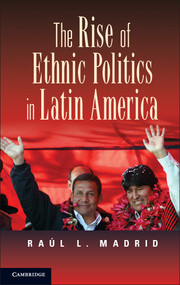Book contents
- Frontmatter
- Contents
- Figures
- Tables
- Acknowledgments
- Abbreviations
- 1 Ethnicity and Ethnopopulism in Latin America
- 2 The Ascent of the MAS in Bolivia
- 3 The Rise and Decline of Pachakutik in Ecuador
- 4 Ethnopopulism without Indigenous Parties in Peru
- 5 Indigenous Parties outside of the Central Andes
- 6 Indigenous Parties and Democracy in the Andes
- 7 Conclusion
- Bibliography
- Index
3 - The Rise and Decline of Pachakutik in Ecuador
Published online by Cambridge University Press: 05 December 2012
- Frontmatter
- Contents
- Figures
- Tables
- Acknowledgments
- Abbreviations
- 1 Ethnicity and Ethnopopulism in Latin America
- 2 The Ascent of the MAS in Bolivia
- 3 The Rise and Decline of Pachakutik in Ecuador
- 4 Ethnopopulism without Indigenous Parties in Peru
- 5 Indigenous Parties outside of the Central Andes
- 6 Indigenous Parties and Democracy in the Andes
- 7 Conclusion
- Bibliography
- Index
Summary
We are no longer Indians that you go to see in a museum. We are not only present; we are also here with proposals.
Luis Macas, in the wake of Pachakutik’s impressive performance in the 1996 elections (Cited in Escobar 1996, A12)In Ecuador, like in Bolivia, the indigenous movement gave birth to a political party in the mid-1990s. This party, the Movimiento Unidad Plurinacional Pachakutik – Nuevo País (MUPP-NP), performed surprisingly well from the start. In the 1996 elections, for example, its presidential candidate, Freddy Ehlers, finished third with 20.6 percent of the valid vote and it won eight seats in the legislature. Its most important breakthrough, however, came in the 2002 elections when the candidate it supported, Lucio Gutiérrez, was elected president, and Pachakutik took control of four cabinet ministries in the new government. Thus, in less than a decade, Pachakutik emerged as a major player in Ecuadorian politics.
The success of the MUPP-NP, like the MAS, was due in part to its ethnic appeals. Pachakutik used a variety of symbolic and substantive appeals to win the support of Ecuador’s indigenous population. It ran numerous indigenous candidates, it campaigned extensively in indigenous areas, and it embraced traditional ethnic demands. Pachakutik also benefited significantly from its close ties to Ecuador’s powerful indigenous movement, which provided it with organizational legitimacy as well as human and material resources. These appeals and resources helped Pachakutik capture much of the indigenous vote beginning in 1996.
- Type
- Chapter
- Information
- The Rise of Ethnic Politics in Latin America , pp. 74 - 107Publisher: Cambridge University PressPrint publication year: 2012



